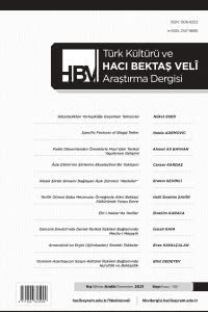İsmaililer: Yanlış Tanıtılan Bir Şii Müslüman Topluluğu
İsmaililer, Şii Müslüman Cemaati, Nizari İsmaililer, Musta’li-Tayyibiler
The Ismailis: A Misrepresented Shiʿi Muslim Community
Ismailis, Shiʿi Muslim Community, Nizari Ismailis, Mustaʿli-Tayyibis. Ismailis, Shiʿi Muslim Community, Nizari Ismailis, Mustaʿli-Tayyibis.,
___
- al-Baghdadi, Abu Mansur ʿAbd al-Qahir b. Tahir. al-Farq bayn al-firaq, ed. M. Badr, Cairo: 1328/1910, pp. 265-299.
- Bobrinskiy, Aleksey A. ‘Sekta Ismailiya v Russkikh i Bukharskikh predelakh Sredney Azii’ [The Ismaili Sect in Russian and Bukharan Central Asia], Étnograficheskoe Obozrenie, 2 (1902), pp. 1–20.
- Casanova, Paul. ‘Monnaie des Assassins de Perse’, Revue Numismatique, 11 (1893), pp. 343–352.
- Cortese, D. Arabic Ismaili Manuscripts: The Zahid ʿAli Collection in the Library of The Institute of Ismaili Studies. London: 2003.
- Daftary, Farhad. ‘ʿAbd Allah b. Maymun al-Qaddah’, in W. Madelung and F. Daftary, ed., Encyclopaedia Islamica. Leiden: 2008, vol. 1, pp. 167-169.
- Daftary, Farhad. “Sinan and the Nizari Ismailis of Syria”, in Daniela Bredi et al., ed., Scritti in onore di Biancamaria Scarcia Amoretti. reprinted in Daftary, Ismaili History and Intellectual Traditions, pp. 238-247. Rome: 2008, vol. 2, pp. 489-500.
- Daftary, Farhad. Ismaili Literature: A Bibliography of Sources and Studies. London: 2004.
- de Blois, F. Arabic, Persian and Gujarati Manuscripts: The Hamdani Collection in the Library of The Institute of Ismaili Studies. London: 2011.
- de Goeje, Michael J. Mémoire sur les Carmathes du Bahraïn et les Fatimides. Leiden: 1862; 2nd. ed., Leiden: 1886.
- de Smet, Daniel. ‘Henry Corbin et études Ismaéliennes’, in M. A. Amir-Moezzi et al., ed., Henry Corbin, Philosophe et sagesses des religions du livre. Turnhout: 2005, pp. 105–118.
- Fyzee, Asaf A. A. Cases in the Muhammadan Law of India and Pakistan. Oxford: 1965, pp. 504–549.
- al-Ghazali, Abu Hamid Muhammad. Fadaʾih al-Batiniyya wa-fadaʾil al-Mustazhiriyya, ed. ʿAbd al-Rahman Badawi. Cairo: 1964, pp. 21-36.
- Guyard, Stanislas. ed. and tr., Fragments rélatifs à la doctrine des Ismaélîs. Paris: 1874.
- Hodgson, Marshall G. S. The Order of Assassins: The Struggle of the Early Nizari Ismaʿilis against the Islamic World. The Hague: 1955; reprinted, New York: 1980; reprinted, Philadelphia: 2005.
- Ibn al-Nadim, Kitab al-Fihrist, ed. G. Flügel. Leipzig: 1871-1872, vol. 1, pp. 186- 187; ed. M. R. Tajaddud, 2nd ed., Tehran: 1973, pp. 238-239.
- Ivanow, Wladimir. Brief Survey of the Evolution of Ismailism. Leiden: 1952.
- Ivanow, Wladimir. Ismaili Literature: A Bibliographical Survey. Tehran: 1963.
- Ivanow, Wladimir. A Guide to Ismaili Literature. London: 1933.
- Ivanow, Wladimir. The Alleged Founder of Ismailism. Bombay: 1946.
- Mitha, Farouk. Al-Ghazali and the Ismailis: A Debate on Reason and Authority in Medieval Islam. London: 2001.
- Niẓām al-Mulk. The Book of Government or Rules for Kings: The Siyar al-muluk or Siyasat-nama of Nizam al-Mulk. Tr. H. Darke. 2d ed., London; Boston: 1978, p. 231.
- O’Leary, De Lacy Evans. A Short History of the Fatimid Khalifate. London: 1923.
- Polo, Marco. The Book of Ser Marco Polo, the Venetian, Concerning the Kingdoms and Marvels of the East, ed. and tr. H. Yule, 3rd revised ed. by H. Cordier. London: 1929, vol. 1, pp. 139-146.
- Poonawala, Ismail K. Biobibliography of Ismaʿili Literature. Malibu, CA: 1977.
- Purohit, T. The Aga Khan Case: Religion and Identity in Colonial India. Cambridge: MA, 2012.
- Silvestre de Sacy, A.I. Exposé de la religion des Druzes. Paris: 1838, vol. 1, pp. 1–246.
- Stroeva, L. V. Gosudarstvo ismailitov v Irane v XI-XIII vv [The Ismaili State in Iran in the 11-13th Centuries]. Moscow: 1978.
- van Berchem, Max. ‘Épigraphie des Assassins de Syrie’, Journal Asiatique, 9 series, 9 (1897), pp. 453–501; reprinted in his Opera Minora. Geneva: 1978, pp. 453–501; also reprinted in Turner, Orientalism, vol. I, pp. 279–309.
- Walker, Paul E. ‘Institute of Ismaili Studies’, Encyclopaedia Iranica, (2002) vol. 12, pp. 164-166.
- ISSN: 1306-8253
- Yayın Aralığı: 4
- Başlangıç: 1994
- Yayıncı: Ankara Hacı Bayram Veli Üniversitesi Türk Kültürü Açısından Hacı Bektaş-ı Veli Araştırmaları Uygulama ve Araştırma Merkezi
Halep’te Yıkılmış Bir Kültür Mirası: Bayram Baba Tekkesi
Sovyetlerin Kutsal Yerlere Yönelik Politikası: Ahmet Yesevi Türbesi Örneği
Gulnur BAIZHANOVA, Talgat ZHOLDASSULY
13. Yüzyıl Türkiye’sinde Dini-Tasavvufi Hayat ve Hacı Bektaş Veli
Ismaili Revival in Tajikistan: From Perestroika to the Present
Musahipsiz Otman Babalılarda Kimlik Mücadelesi
Mehmet Reşat Ata, Kutsal Bekâr “Mücerret”, İnciay Yayınları, Mersin, 2007
